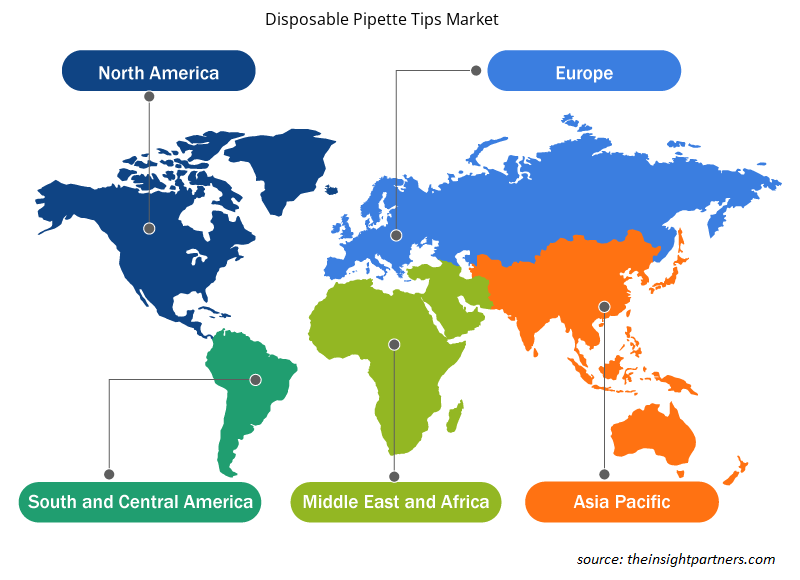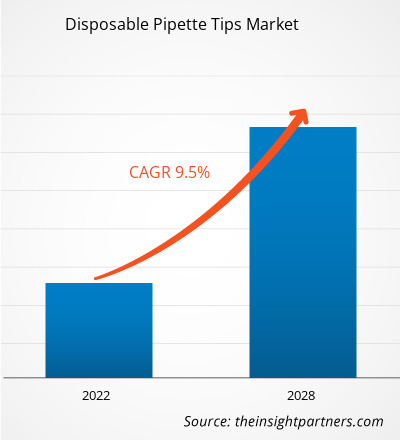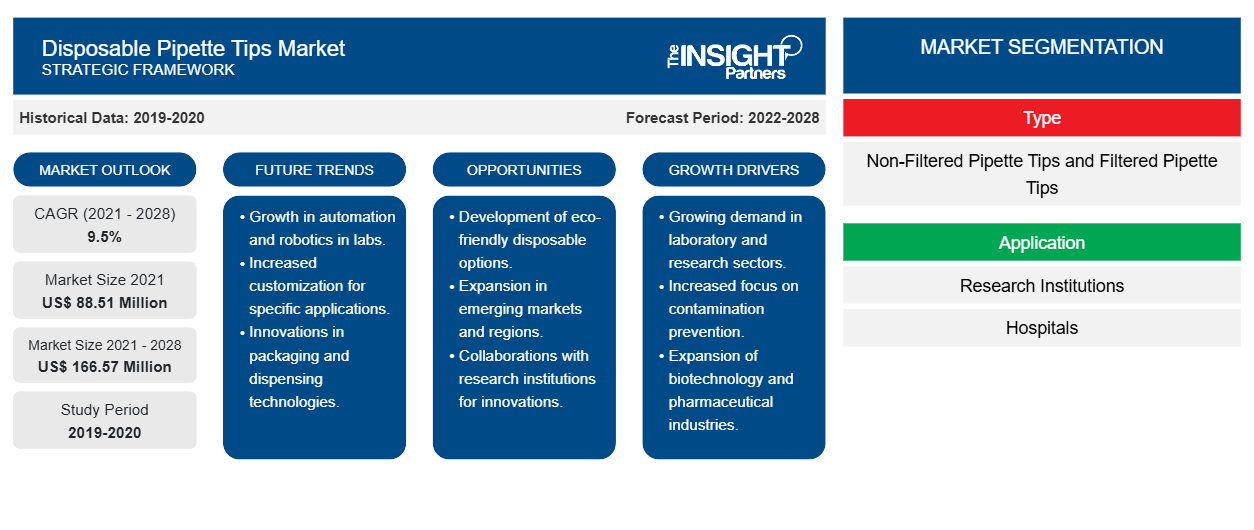Le marché des pointes de pipettes jetables devrait atteindre 166,57 millions de dollars américains d'ici 2028, contre 88,51 millions de dollars américains en 2021 ; il devrait croître à un TCAC de 9,5 % de 2021 à 2028.
Les pointes de pipettes jetables sont de petite taille et ont une forme conique. Les pointes sont fabriquées en plastique moulé. Les scientifiques fixent une pointe de pipette à l'extrémité d'une pipette, puis l'utilisent pour transférer le liquide. Le liquide utilisé dans la pointe de la pipette est mesuré en microlitres (μL), ou un millième de millilitre (mL). Les pointes de pipettes sont fabriquées conformément aux normes et standards de qualité internationaux. Elles sont proposées en différentes couleurs et tailles pour répondre aux exigences exactes des clients.
Le rapport offre des informations et une analyse approfondie du marché des pointes de pipettes jetables , en mettant l'accent sur divers paramètres tels que les tendances du marché, les avancées technologiques, la dynamique du marché et l'analyse du paysage concurrentiel des principaux acteurs du marché mondial. Il comprend également l'impact de la pandémie de COVID-19 sur le marché dans toutes les régions. La pandémie a perturbé les conditions socio-économiques de divers pays à travers le monde. Actuellement, les États-Unis sont le pays le plus touché au monde en raison de l'épidémie de COVID-19 avec le plus grand nombre de cas confirmés et de décès, selon les récentes statistiques de l'OMS. Le nombre élevé de cas positifs de COVID-19 a eu un impact négatif sur les économies mondiales. Il y a eu un déclin des activités commerciales globales et une croissance de diverses industries opérant dans le monde entier.
Français Au milieu de l'année 2020, de nombreuses entreprises ont augmenté leurs investissements pour accroître la capacité de production de pointes de pipettes afin de soutenir les diagnostics et les traitements du COVID-19. En octobre 2020, le groupe Tecan a reçu un contrat de 32,9 millions de dollars américains (29,8 millions de francs suisses) du ministère américain de la Défense (DoD) et du ministère américain de la Santé et des Services sociaux (HHS) pour soutenir l'expansion de la fabrication de pointes de pipettes aux États-Unis pour les tests COVID-19. Les pointes de pipettes jetables sont un élément important des tests moléculaires pour le SARS-CoV-2 et d'autres tests exécutés sur des systèmes à haut débit entièrement automatisés. Les nouvelles lignes de fabrication aux États-Unis devraient commencer à produire des pointes de pipettes à l'automne 2021, ce qui permettra d'augmenter la capacité de test nationale de plusieurs millions de tests par mois d'ici décembre de la même année. Avec l'augmentation de la recherche et des tests de diagnostic, la demande de pipettes, de pointes de pipettes, de plaques à puits et d'autres consommables liés au diagnostic a augmenté et devrait croître vigoureusement au cours de la période de prévision. Les problèmes liés au COVID-19 ont propulsé la croissance du marché des pointes de pipettes jetables.
En fonction de la région, le marché des pointes de pipettes jetables est segmenté en Amérique du Nord, en Europe, en Asie-Pacifique, au Moyen-Orient et en Afrique, ainsi qu'en Amérique du Sud et en Amérique centrale.
Personnalisez ce rapport en fonction de vos besoins
Vous bénéficierez d'une personnalisation gratuite de n'importe quel rapport, y compris de certaines parties de ce rapport, d'une analyse au niveau des pays, d'un pack de données Excel, ainsi que de superbes offres et réductions pour les start-ups et les universités.
-
Obtenez les principales tendances clés du marché de ce rapport.Cet échantillon GRATUIT comprendra une analyse de données, allant des tendances du marché aux estimations et prévisions.
Informations sur le marché
Les progrès croissants dans le secteur de la santé stimulent le marché des pointes de pipettes jetables
Les entreprises de biotechnologie du monde entier intensifient leurs efforts pour développer des produits et des solutions avancés pour traiter les maladies sans erreur. En outre, la croissance du marché pharmaceutique ainsi que l'augmentation des investissements dans la R&D et l'augmentation des approbations de médicaments à travers le monde devraient propulser la croissance du marché des pointes de pipettes jetables dans les années à venir. Les dépenses mondiales en R&D dans les industries de la santé se sont élevées à environ 32,8 milliards de dollars américains en 2020. Ce chiffre devrait augmenter à mesure que les entreprises injectent davantage de fonds pour améliorer leurs produits. Grâce aux avancées technologiques dans le secteur de la santé, des améliorations significatives sont largement apportées aux matériaux de pipetage, du verre aux plastiques de haute qualité.pipetting materials, from glass to high-grade plastics.
En outre, les fabricants de différentes régions, ainsi que les gouvernements locaux, recherchent de plus en plus de nouvelles approches pour répondre à la forte demande de fabrication de médicaments et de vaccins existants et nouveaux. Pour combler ce déficit d'offre et de demande, de nombreuses sociétés biopharmaceutiques, instituts de recherche, organisations de recherche sous contrat (CRO) et organisations de développement et de fabrication sous contrat (CDMO) ont adopté l'automatisation dans les laboratoires pour une précision élevée et des délais d'exécution réduits. En outre, le nombre croissant d'essais cliniques, le développement du pipeline pharmaceutique, la sensibilisation croissante à l'automatisation des laboratoires, la demande croissante de haute précision dans la manipulation des liquides et la préparation des échantillons, le nombre croissant d'études de recherche au fil du temps et l'adoption croissante de systèmes automatisés de manipulation des liquides dans les laboratoires de découverte de médicaments et de diagnostic propulsent la croissance du marché.biopharmaceutical companies, research institutes, contract research organizations (CROs), and contract development & manufacturing organizations (CDMOs), adopted automation in laboratories for high precision and low turnaround time. Furthermore, the rising number of clinical trials, growing pharmaceutical pipeline, increasing awareness regarding lab automation, surging demand for high precision in liquid handling and sample preparation, an increasing number of research studies over time, and the rising adoption of automated
De plus, le pipetage et l'ergonomie sont devenus des aspects pratiquement indissociables. Des progrès considérables ont été réalisés pour réduire le stress et la fatigue des utilisateurs afin de réduire le nombre de réactifs utilisés dans les processus pour économiser les coûts et la précision, créant ainsi un impact positif sur la croissance du marché des pointes de pipettes jetables.
Informations basées sur les types
En fonction du type, le marché des pointes de pipettes jetables est divisé en pointes de pipettes non filtrées et pointes de pipettes filtrées . En 2021, le segment des pointes de pipettes non filtrées représentait une part plus importante du marché. Les pointes sans barrière sont le cheval de bataille de tout laboratoire et sont généralement l'option la plus abordable. Ces pointes sont disponibles en grande quantité (c'est-à-dire dans un sac) et pré-emballées (c'est-à-dire dans des racks qui peuvent être facilement placés dans des boîtes). Les pointes de pipettes non filtrées sont soit pré-stérilisées, soit non stérilisées. Les pointes sont disponibles pour les pipettes manuelles ainsi que pour une pipette automatisée. La majorité des acteurs du marché, tels que Labcon, Corning Incorporated et Tecan Trading AG, proposent ces types de pointes.
Informations basées sur les applications
En fonction des applications, le marché des pointes de pipettes jetables est segmenté en hôpitaux, instituts de recherche et autres. Le segment des instituts de recherche détenait la plus grande part du marché en 2021, et le même segment devrait enregistrer le TCAC le plus élevé de 10,0 % du marché au cours de la période de prévision.
Informations basées sur le type de produit
En fonction du type de produit, le marché des pointes de pipettes jetables est segmenté en pointes de pipettes robotisées et pointes de pipettes non robotisées. Le segment des pointes de pipettes robotisées détenait la plus grande part du marché en 2021, et le même segment devrait enregistrer le TCAC le plus élevé de 10,5 % du marché au cours de la période de prévision.
Les acteurs du marché des pointes de pipettes jetables adoptent des stratégies organiques telles que le lancement et l’expansion de produits pour étendre leur empreinte et leur portefeuille de produits dans le monde entier et répondre à la demande croissante.
Aperçu régional du marché des pointes de pipettes jetables
Les tendances et facteurs régionaux influençant le marché des pointes de pipettes jetables tout au long de la période de prévision ont été expliqués en détail par les analystes d’Insight Partners. Cette section traite également des segments et de la géographie du marché des pointes de pipettes jetables en Amérique du Nord, en Europe, en Asie-Pacifique, au Moyen-Orient et en Afrique, ainsi qu’en Amérique du Sud et en Amérique centrale.

- Obtenez les données régionales spécifiques au marché des pointes de pipettes jetables
Portée du rapport sur le marché des pointes de pipettes jetables
| Attribut de rapport | Détails |
|---|---|
| Taille du marché en 2021 | 88,51 millions de dollars américains |
| Taille du marché d'ici 2028 | 166,57 millions de dollars américains |
| Taux de croissance annuel moyen mondial (2021-2028) | 9,5% |
| Données historiques | 2019-2020 |
| Période de prévision | 2022-2028 |
| Segments couverts |
Par type
|
| Régions et pays couverts |
Amérique du Nord
|
| Leaders du marché et profils d'entreprises clés |
|
Densité des acteurs du marché : comprendre son impact sur la dynamique des entreprises
Le marché des pointes de pipettes jetables connaît une croissance rapide, tirée par la demande croissante des utilisateurs finaux en raison de facteurs tels que l'évolution des préférences des consommateurs, les avancées technologiques et une plus grande sensibilisation aux avantages du produit. À mesure que la demande augmente, les entreprises élargissent leurs offres, innovent pour répondre aux besoins des consommateurs et capitalisent sur les tendances émergentes, ce qui alimente davantage la croissance du marché.
La densité des acteurs du marché fait référence à la répartition des entreprises ou des sociétés opérant sur un marché ou un secteur particulier. Elle indique le nombre de concurrents (acteurs du marché) présents sur un marché donné par rapport à sa taille ou à sa valeur marchande totale.
Les principales entreprises opérant sur le marché des pointes de pipettes jetables sont :
- Eppendorf
- Analytik Jena GmbH
- Mettler Toledo
- Thermo Fisher Scientific
- Sartorius SA
Avis de non-responsabilité : les sociétés répertoriées ci-dessus ne sont pas classées dans un ordre particulier.

- Obtenez un aperçu des principaux acteurs du marché des pointes de pipettes jetables
Par type
- Embouts de pipettes sans filtre
- Embouts de pipettes filtrés
Par application
- Institutions de recherche
- Hôpital
- Autres
Par type de produit
- Embouts de pipettes robotisées
- Embouts de pipettes non robotisés
Par
Géographie
-
Amérique du Nord
- NOUS
- Canada
- Mexique
-
Europe
- France
- Allemagne
- Italie
- ROYAUME-UNI
- Espagne
- Reste de l'Europe
-
Asie-Pacifique (APAC)
- Chine
- Inde
- Corée du Sud
- Japon
- Australie
- Reste de l'APAC
-
Moyen-Orient et Afrique (MEA)
- Afrique du Sud
- Arabie Saoudite
- Émirats arabes unis
- Reste de la MEA
-
Amérique du Sud et Amérique centrale (SCAM)
- Brésil
- Argentine
- Reste de SCAM
Profils d'entreprise
- Eppendorf
- Analytik Jena GmbH
- Mettler Toledo
- Thermo Fisher Scientific
- Sartorius SA
- Tecan Trading AG
- Corning Incorporated
- INTEGRA Holding SA
- Laboratoire de recherche
- Socorex Isba SA
- Analyse historique (2 ans), année de base, prévision (7 ans) avec TCAC
- Analyse PEST et SWOT
- Taille du marché Valeur / Volume - Mondial, Régional, Pays
- Industrie et paysage concurrentiel
- Ensemble de données Excel
Rapports récents
Rapports connexes
Témoignages
Raison d'acheter
- Prise de décision éclairée
- Compréhension de la dynamique du marché
- Analyse concurrentielle
- Connaissances clients
- Prévisions de marché
- Atténuation des risques
- Planification stratégique
- Justification des investissements
- Identification des marchés émergents
- Amélioration des stratégies marketing
- Amélioration de l'efficacité opérationnelle
- Alignement sur les tendances réglementaires























 Obtenez un échantillon gratuit pour - Marché des pointes de pipettes jetables
Obtenez un échantillon gratuit pour - Marché des pointes de pipettes jetables